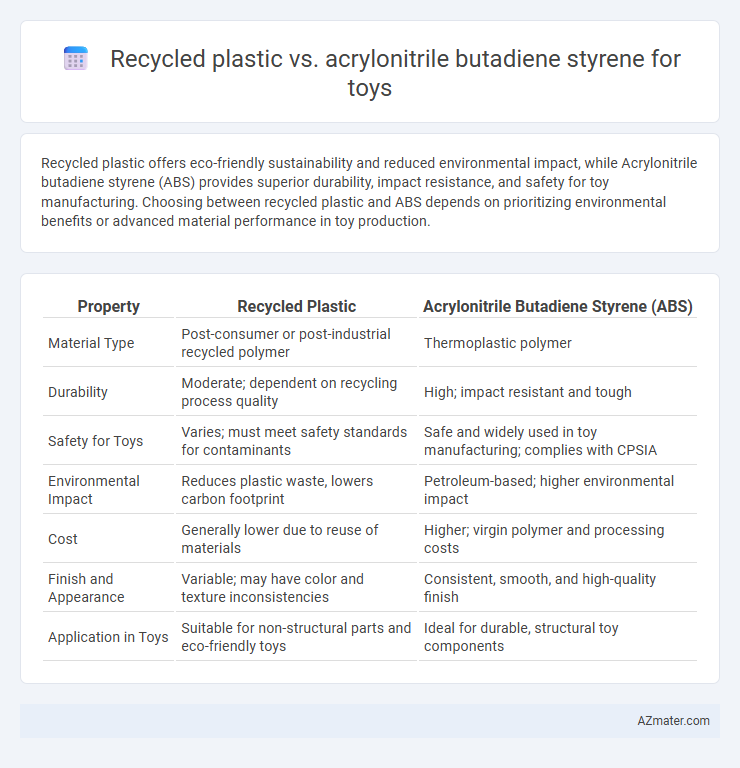Recycled plastic offers eco-friendly sustainability and reduced environmental impact, while Acrylonitrile butadiene styrene (ABS) provides superior durability, impact resistance, and safety for toy manufacturing. Choosing between recycled plastic and ABS depends on prioritizing environmental benefits or advanced material performance in toy production.
Table of Comparison
| Property | Recycled Plastic | Acrylonitrile Butadiene Styrene (ABS) |
|---|---|---|
| Material Type | Post-consumer or post-industrial recycled polymer | Thermoplastic polymer |
| Durability | Moderate; dependent on recycling process quality | High; impact resistant and tough |
| Safety for Toys | Varies; must meet safety standards for contaminants | Safe and widely used in toy manufacturing; complies with CPSIA |
| Environmental Impact | Reduces plastic waste, lowers carbon footprint | Petroleum-based; higher environmental impact |
| Cost | Generally lower due to reuse of materials | Higher; virgin polymer and processing costs |
| Finish and Appearance | Variable; may have color and texture inconsistencies | Consistent, smooth, and high-quality finish |
| Application in Toys | Suitable for non-structural parts and eco-friendly toys | Ideal for durable, structural toy components |
Introduction to Toy Materials: Recycled Plastic vs ABS
Recycled plastic and acrylonitrile butadiene styrene (ABS) are prominent materials used in toy manufacturing, each offering distinct environmental and mechanical properties. Recycled plastic reduces waste and lowers carbon footprint by repurposing post-consumer materials, while ABS provides superior strength, impact resistance, and surface finish essential for durable, high-quality toys. Understanding the trade-offs between sustainability and performance helps manufacturers select the optimal material for safety, cost, and environmental impact in toy production.
Environmental Impact: Recycled Plastic vs ABS
Recycled plastic significantly reduces environmental impact by diverting waste from landfills and lowering carbon emissions through resource reuse, contrasting with Acrylonitrile Butadiene Styrene (ABS), which relies on petroleum-based raw materials and energy-intensive production processes. ABS manufacturing generates higher greenhouse gas emissions and is less biodegradable, leading to longer environmental persistence compared to recycled plastics. Using recycled plastic in toys supports circular economy principles and decreases reliance on virgin polymers, promoting sustainability in the toy industry.
Safety and Toxicity in Toy Production
Recycled plastic in toy production often raises concerns over contaminants and inconsistent material quality, which can increase the risk of harmful chemical exposure to children. Acrylonitrile butadiene styrene (ABS) is widely preferred for toys due to its strong safety profile, durability, and non-toxic properties certified by regulatory bodies such as the FDA and ASTM. ABS's stability under heat and resistance to impact make it a safer option in preventing chemical leaching compared to many recycled plastics.
Durability and Strength Comparison
Recycled plastic offers moderate durability and strength but often falls short of meeting the rigorous demands for impact resistance and long-term wear in toys compared to Acrylonitrile Butadiene Styrene (ABS). ABS is known for its high tensile strength, excellent impact resistance, and ability to maintain structural integrity under stress, making it a preferred choice for durable and safe toy manufacturing. The superior mechanical properties of ABS ensure enhanced performance and longevity, especially in toys subjected to rough handling and frequent use.
Manufacturing Process Differences
Recycled plastic used in toy manufacturing often involves sorting, cleaning, and re-melting mixed plastic waste, which can cause variability in material properties and require additional additives for consistency. Acrylonitrile butadiene styrene (ABS) production relies on precise polymerization and compounding steps to achieve uniform strength, rigidity, and color, ensuring high-quality molding performance. The manufacturing process of ABS allows for better control over mechanical properties and surface finish compared to the less predictable recycling process of mixed plastics.
Cost Efficiency for Manufacturers
Recycled plastic offers significantly lower raw material costs compared to Acrylonitrile Butadiene Styrene (ABS), enhancing cost efficiency for toy manufacturers. While ABS provides superior durability and aesthetic quality, its higher price and processing requirements increase overall production expenses. Utilizing recycled plastic reduces material procurement and waste disposal costs, making it an economically attractive option for large-scale toy manufacturing.
Design Flexibility and Aesthetics
Recycled plastic offers moderate design flexibility and a unique, often textured aesthetic that appeals to environmentally conscious consumers but can limit intricate detailing compared to acrylonitrile butadiene styrene (ABS). ABS excels in design precision with superior impact resistance and smooth finishes, enabling complex shapes and vibrant colors ideal for high-quality toy production. The choice between recycled plastic and ABS hinges on balancing sustainability priorities with the desired level of design sophistication and aesthetic appeal.
Consumer Perception and Market Trends
Consumer perception favors recycled plastic toys for their environmental sustainability and eco-friendly appeal, driving demand among environmentally conscious parents. Acrylonitrile butadiene styrene (ABS) remains preferred for its durability, safety certifications, and vibrant finish, making it a staple in premium toy segments. Market trends indicate a growing investment in recycled plastics by toy manufacturers aiming to balance sustainability with performance, reflecting increased regulatory pressures and shifting consumer values.
Regulatory Compliance and Certifications
Recycled plastic toys must comply with stringent regulations such as the EU's REACH and the U.S. CPSIA, ensuring low levels of toxic substances and safe phthalate content. Acrylonitrile butadiene styrene (ABS) is widely certified under standards like ASTM F963 and EN71, guaranteeing impact resistance and non-toxicity for children's products. Both materials require thorough testing for heavy metals, BPA, and other hazardous chemicals to achieve certifications like ISO 8124 and CE marking for global market compliance.
Future Outlook: Sustainable Toys
Recycled plastic offers a sustainable solution for toy manufacturing by reducing environmental impact and conserving resources, aligning with growing consumer demand for eco-friendly products. Acrylonitrile butadiene styrene (ABS), though durable and versatile, poses challenges in recyclability and environmental footprint compared to recycled plastics. The future outlook for sustainable toys emphasizes increased use of recycled materials, advancements in biodegradable additives, and innovation in circular economy practices to minimize plastic waste in the toy industry.

Infographic: Recycled plastic vs Acrylonitrile butadiene styrene for Toy
 azmater.com
azmater.com